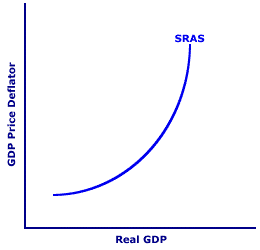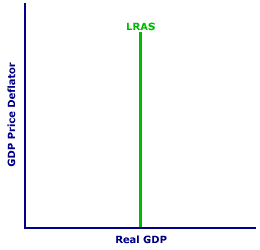
|
|
NEAR-PUBLIC GOOD: A good that's easy to keep nonpayers from consuming, but use of the good by one person doesn't prevent use by others. The trick with a near-public good is that it's easy to keep people away, and thus you can charge them a price for consuming, but there's no real good reason to do so. From an efficiency view, the more people who consume a near-public good, the better off society. This mixture of nearly unlimited benefits and the ability to charge a price means that some near-public goods are sold through markets and others are provided by government. For efficiency's sake, none should be sold through markets.
Visit the GLOSS*arama
|
|


|

|
                           CHANGE IN AGGREGATE SUPPLY: A shift of the short-run or long-run aggregate supply curve caused by a change in one of the aggregate supply determinants. In essence, a change in aggregate supply is caused by any factor affecting supply EXCEPT the price level. This is one of two changes related to aggregate supply. The other is a change in real production. A change in aggregate supply is comparable to a change in market supply. A change in aggregate supply is a shift in one of the aggregate supply curves--short run or long run. Because aggregate supply includes ALL price level-real production combinations, a change in aggregate supply is a change in ALL price level-real production combinations, meaning that each price level is matched up with a different real production after the change. This is illustrated as a shift of one of the aggregate supply curves. This change in aggregate supply is caused by a change in any of the aggregate supply determinants. In contrast, a change in real production is a change from one price level-real production combination on a given aggregate supply curve to another point on the same curve. This is illustrated as a movement along a given aggregate supply curve. | Change in SR Aggregate Supply | 
| Change in LR Aggregate Supply | 
|
The exhibit to the right displays two curves--the short-run aggregate supply curve (SRAS) in the top panel and the long-run aggregate supply curve (LRAS) in the bottom panel. A change in aggregate supply is illustrated by a shift in either curve. To illustrate how this transpires, click the [Determinant and SR] button in the top panel or the [Determinant and LR] button in the bottom panel. Upon clicking either button, the corresponding aggregate supply curve shifts to the right, illustrating an increase in aggregate supply, and more generally, a change in aggregate supply.The contrasting change is a change in real production--the movement along an aggregate supply curve. To illustrate this change, click the [Price Level and SR] button in the top panel or [Price Level and LR] button in the bottom panel. The click of either button illustrates a movement along the corresponding curve. While the phrase "change in real production" is used for both curves to indicate a movement along the curve, because real production is constant in the long run, real production actually '" changes" only by moving along the short-run aggregate supply curve. Why is the difference a change in aggregate supply and a change in real production so important? The answer is as simple as cause and effect. The aggregate supply curves are used (together with the aggregate demand curve) to explain and analyze macroeconomic events, especially business-cycle instability. The sequence of events follows a particular pattern. - First, a determinant (of either aggregate demand or aggregate supply) changes.
- Second, this determinant change causes one of the aggregate supply curves or the aggregate demand curve to shift. An aggregate supply determinant change causes a shift in one of the aggregate supply curves and an aggregate demand determinant change causes a shift of the aggregate demand curve.
- Third, the change in aggregate supply or aggregate demand causes an imbalance in the aggregate market (an economy-wide shortage or surplus). The aggregate market is in a temporary state of disequilibrium.
- Fourth, the economy-wide shortage or surplus causes the price level to change.
- Fifth, the change in the price level causes a change in aggregate expenditures and possibly real production (in the short run).
- Sixth, the changes in aggregate expenditures and/or real production eliminate the shortage or surplus and restore equilibrium.
The key conclusion is that aggregate supply (and aggregate demand) determinants, which induce changes in aggregate supply (and aggregate demand), are the source of instability in the aggregate market. The change in the price level, which induces a change in real production (and aggregate expenditures) is the means of eliminating the instability and restoring equilibrium.

Recommended Citation:CHANGE IN AGGREGATE SUPPLY, AmosWEB Encyclonomic WEB*pedia, http://www.AmosWEB.com, AmosWEB LLC, 2000-2024. [Accessed: May 2, 2024].
Check Out These Related Terms... | | | | | | |
Or For A Little Background... | | | | | | | | | | | | |
And For Further Study... | | | | | | | | | | | | | | | |
Search Again?
Back to the WEB*pedia
|



|

|
GRAY SKITTERY
[What's This?]
Today, you are likely to spend a great deal of time waiting for visits from door-to-door solicitors seeking to buy either a wall poster commemorating the first day of winter or blue cotton balls. Be on the lookout for celebrities who speak directly to you through your television.
Your Complete Scope
This isn't me! What am I?
|

|
|
Cyrus McCormick not only invented the reaper for harvesting grain, he also invented the installment payment for selling his reaper.
|

|
|
"Leadership is based on inspiration, not domination; on cooperation, not intimidation. " -- William A. Ward
|

|
IBRD
International Bank for Reconstruction and Development
|

|
|
Tell us what you think about AmosWEB. Like what you see? Have suggestions for improvements? Let us know. Click the User Feedback link.
User Feedback
|


|


